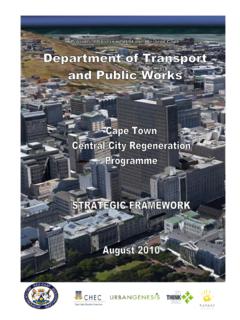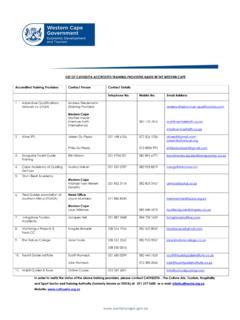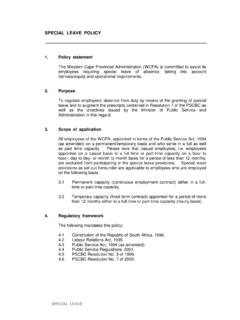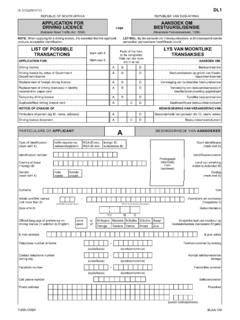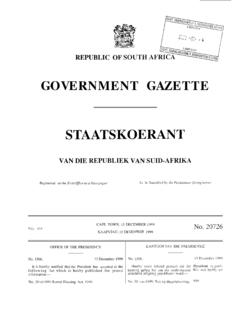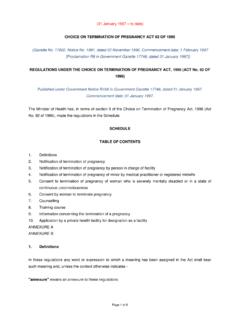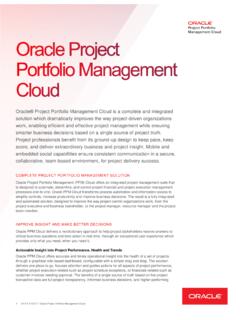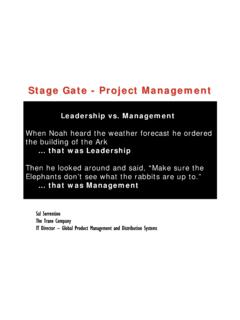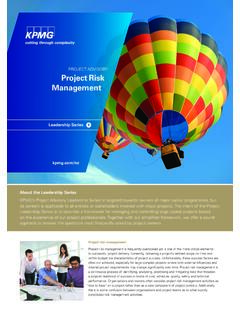Transcription of PROJECT MANAGEMENT APPROACH - Western Cape
1 Modernisation Programme: PROJECT MANAGEMENT APPROACH 1 PROJECT MANAGEMENT APPROACH 13 November 2009 Version Ref no: 4/3 Modernisation Programme: PROJECT MANAGEMENT APPROACH 2 Table of Contents 1. INTRODUCTION ..3 Modernisation Programme ..3 Problem Scope ..5 2. 3. KEY FINDINGS ..8 Current Status of Performance MANAGEMENT Systems in the PGWC ..9 Strategic Performance MANAGEMENT PROJECT MANAGEMENT Maturity ..12 PROJECT MANAGEMENT Information Systems ..12 PROJECT Content ..13 4. DISCUSSION ..15 Rationale to the PROJECT MANAGEMENT APPROACH ..15 Planning and Budgeting ..15 PROJECT MANAGEMENT Methodology ..15 PROJECT MANAGEMENT Information System (Executive Projects Dashboard) .17 PROJECT MANAGEMENT Maturity ..17 PROJECT MANAGEMENT Structure ..20 PROJECT Governance ..23 Communications ..24 Risk MANAGEMENT ..25 5. CONCLUSION ..27 Response to Problem Statement.
2 27 Progressive Implementation ..27 Potential Benefits ..27 Sustainability ..28 6. RECOMMENDATIONS ..29 PROJECT MANAGEMENT Methodology ..29 PROJECT MANAGEMENT Maturity ..29 PROJECT MANAGEMENT Provincial PROJECT MANAGEMENT Steering Committee ..29 PROJECT MANAGEMENT Training ..30 Communications ..30 Executive Projects Dashboard ..31 Content ..31 Risk MANAGEMENT ..31 7. HUMAN RESOURCE IMPLICATION ..32 PROJECT MANAGEMENT 33 8. FINANCIAL IMPLICATION ..33 Costing ..34 9. Glossary 35 Modernisation Programme: PROJECT MANAGEMENT APPROACH 3 1. INTRODUCTION Modernisation Programme Origin of the Modernisation Programme Shortly after the appointment of the Provincial Cabinet of the Western Cape in May 2009, Premier Helen Zille and her team of MECs conducted a broad assessment of the challenges facing government departments. At a macro-economic level it was clear that the global downturn in the economy eroded the Government s tax base resulting in the Provincial Government of the Western Cape (PGWC) having to deliver the same or more - services with fewer resources.
3 Secondly, there are growing expectations that public service institutions need to be more accountable to stakeholders and improve service delivery. Finally, governments, like private sector organisations, are increasingly experiencing skills shortages in certain critical areas. In response to these challenges it was decided to embark on a modernisation programme for the PGWC which has the following objectives: To bring provincial government institutions on par with international best practice; to ensure that those institutions are fit for their respective intended purposes; and to ensure that they serve the public sector in a cost effective and efficient manner. In order to achieve these objectives, various processes have been identified for modernisation and clustered under the following core themes: Legislative frameworks; Organisational Capacity Building; Physical Resource MANAGEMENT ; and E-Governance.
4 E-Governance The e-Governance cluster was assigned the responsibility of ensuring that Information and Communication Technology Systems, processes and structures are best positioned and applied to improve effective and efficient service delivery. The following objectives are included in the brief of this cluster: To assess the current IT service delivery model through an IT services workstream; to optimise existing filing systems and introduce uniform e-filing practices through a Registry/e-Filing workstream; and to develop a system and implement an APPROACH to establish and institutionalise delivery of all objectives on a PROJECT MANAGEMENT basis. Two workstreams, namely the Projects MANAGEMENT APPROACH and the Executive Projects Dashboard, were established. Due to the integrated nature of the work of the two streams and the interdependencies between the two, the Modernisation Steering Committee agreed on the combination of these workstreams into a single one to manage the implementation of the Executive Dashboard, the PROJECT MANAGEMENT APPROACH and to address the quality of the content being captured on the system.
5 Modernisation Programme: PROJECT MANAGEMENT APPROACH 4 Problem statement Turning strategy into reality is not a function in which the public service is known to excel. This deficiency has caused many political principals huge embarrassment as they often had brilliant visionary abilities and provided strong direction, yet the operationalisation of their visions left much to be desired. There are various factors which can be attributed to Government s inability to deliver on the vision of executing authorities, of which the lack of adequate skills, lack of funding, high vacancy rates, inadequate systems, non-cooperation from other spheres of government and administrative red tape are often identified as the major causes. At times the lack of planning and or performance MANAGEMENT are also identified as possible causes, but that puts the spotlight on the department itself whereas the factors mentioned previously can easily be placed at the door of a third party.
6 When looking objectively at the prescribed planning and budgeting processes of the departments it becomes evident that the formal processes do allow for adequate discussion and consultation. Policy priorities, strategic objectives and funding options are thoroughly discussed at structures such as the Medium Term Expenditure Committee (MTEC) and the Standing Committees on Public Accounts (SCOPA). Therefore, nothing which reflects in departments annual performance plans is enforced without budgetary consideration. Departments determine their own score sheets which should take into account issues such as vacancy levels, funding of and availability of skills, and red tape requirements. This leads to the hypothesis that service delivery inefficiency and ineffectiveness is partly due to a lack of a PROJECT MANAGEMENT APPROACH to delivering on objectives as well as the absence of a system that provides a consolidated projects portfolio view to enable performance MANAGEMENT at strategic level.
7 It is important to note that this hypothesis identifies the problem: service delivery inefficiency and ineffectiveness and attributes it partly to the root cause: a lack of a PROJECT MANAGEMENT APPROACH to achieving objectives . The lack of PROJECT based MANAGEMENT practices is evident through a plethora of symptoms which include: Poorly documented and structured initiation and prioritising of deliverables; Inadequate or no planning of activities that lead to the achievement of intended deliverables; Poor execution of activities; Weak monitoring and controlling mechanisms; and Late completion of projects and little or no formal sign-off thereof. The challenge for the PGWC therefore lies in its ability to address the causal factor by implementing a PROJECT MANAGEMENT APPROACH to all activities performed by all departments. Modernisation Programme: PROJECT MANAGEMENT APPROACH 5 Scope Implementing a PROJECT MANAGEMENT APPROACH (PMA) requires focus on the following specific areas namely: a.
8 Establishing PROJECT MANAGEMENT structures within the PGWC The backbone of the PMA is the establishment of PROJECT MANAGEMENT structures within the PGWC. All departments are not of the same size and do not have the same number of projects; hence a single APPROACH is not appropriate. As the Organisational Design Workstream is responsible for recommending structures, this workstream s role will be to make recommendations on the structures required for the implementation of the PMA. b. The PROJECT MANAGEMENT methodology to be applied and established This area of responsibility will ensure that the PROJECT MANAGEMENT APPROACH is based on international best practices, including determining a standard methodology, developing guidelines, directives, templates, and compliance requirements.
9 C. Developing and maintaining information systems to support PROJECT MANAGEMENT functions The Executive Projects Dashboard has been developed as a PROJECT tracking and reporting system. Recommendations will be made about end-user PROJECT MANAGEMENT tools, as well as the development of a transversal PROJECT MANAGEMENT system. d. PROJECT MANAGEMENT training and capacity-building The development of training material as well as ensuring that training is provided to all relevant officials. It also includes a framework for certification of PROJECT managers. This element also includes communication deliverables that will assist with change MANAGEMENT regarding PROJECT MANAGEMENT in the organisation. e. Ensuring meaningful data is captured onto the system(s) Quality data is a key success factor for the implementation of the PROJECT MANAGEMENT APPROACH , as the usefulness of the reports generated will be its main business benefit.
10 It is therefore important that careful attention is given to the data captured in terms of structure, format, accuracy, completeness and timeliness. In terms of geographical scope this workstream will initially only focus on Provincial Departments within the Western Cape Province. It is possible that a political decision could be taken at a later stage to roll this APPROACH and system out to other spheres of government, both within and outside of this Province. Should this transpire, a new team will be set up to work alongside this workstream to address the expanded requirements. Modernisation Programme: PROJECT MANAGEMENT APPROACH 6 2. METHODOLOGY Literature review A literature review is a method of secondary data collection in order to obtain a better understanding of the subject at hand before commencing with collection of primary data.

